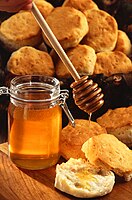
Photo from wikipedia
Pine honey is a honeydew honey produced in the East Mediterranean region (Greece and Turkey) from the secretions of the plant sucking insect Marchalina hellenica (Gennadius) (Coccoidea: Marchalini-dae) feeding on… Click to show full abstract
Pine honey is a honeydew honey produced in the East Mediterranean region (Greece and Turkey) from the secretions of the plant sucking insect Marchalina hellenica (Gennadius) (Coccoidea: Marchalini-dae) feeding on living parts of Pinus species. Nowadays, honeydew honey has attracted great attention due to its biological activities. The aim of this study was to study unifloral pine honey samples produced in Greece regarding their physicochemical parameters and antioxidant and antibacterial activity against five nosocomial and foodborne pathogens. These honeys showed physicochemical and microscopic characteristics within the legal limits, except for diastase activity, a parameter known to be highly variable, depending on various factors. Substantially higher levels of H2O2 were estimated compared to other types of honeydew honey, whereas protein content was similar. The total phenolic content was 451.38 ± 120.38 mg GAE/kg and antiradical activity ranged from 42.43 to 79.33%, while FRAP values (1.87 to 9.43 mmol Fe+2/kg) were in general higher than those reported in the literature. Various correlations could be identified among these parameters. This is the first attempt to investigate in depth the antibacterial activity of pine honey from Greece and correlate it with honey quality parameters. All tested honeys exerted variable but significant antibacterial activity, expressed as MIC and MBC values, comparable or even superior to manuka honey for some tested samples. Although honey antibacterial activity is mainly attributed to hydrogen peroxide and proteins in some cases (demonstrated by elevated MICs after catalase and Proteinase K treatment, respectively), no strong correlation between the antibacterial activity and hydrogen peroxide concentration or total protein content was demonstrated in this study. However, there was a statistically significant correlation of moisture, antioxidant and antibacterial activity against Klebsiella pneuomoniae, as well as antioxidant and antibacterial activity against Salmonella ser. Typhimurium. Interestingly, a statistically significant negative correlation has been observed between diastase activity and Staphylococcus aureus antibacterial activity. Overall, our data indicate multiple mechanisms of antibacterial activity exerted by pine honey.
Journal Title: Foods
Year Published: 2022
Link to full text (if available)
Share on Social Media: Sign Up to like & get
recommendations!